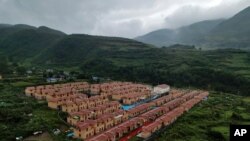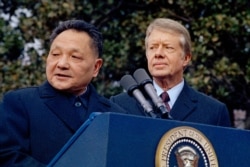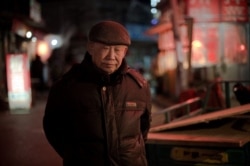For more than four decades, China has been among the world’s fastest-growing economies, which the World Bank has described in a widely quoted phrase as “the fastest sustained expansion by a major economy in history.”
By the numbers, that has meant real annual gross domestic product (GDP) growth averaging 9.5% through 2018. But such a whirlwind of expansion left many Chinese families in absolute poverty, a problem Beijing declared eliminated last month.
China vanquished absolute poverty, a signature goal of President Xi Jinping, in part by using World Bank standards for the world’s poorest nations that did not reflect the nation’s current status as an upper-middle-class country, according to international analysts.
Now Beijing has set its sights on reducing the income gap between rural and urban areas.
Achieving prosperity for all is more than an economic issue, it is a major political issue critical to the rule of China’s Communist Party (CCP), Xi told the National Poverty Alleviation and Commendation Conference on February 25 when he announced the end of absolute poverty.
Poverty alleviation has been the CCP’s top priority since its 18th National Congress, in November 2012, and that involves “lifting all rural residents living below the current poverty line out of poverty” according to China’s state media Xinhua News Agency.
Deng's long game
The idea of common prosperity is nothing new to the average Chinese citizen. The late Deng Xiaoping, the father of “socialism with Chinese characteristics,” announced economic reforms in 1978 with the ultimate goal of achieving common prosperity. The reforms he instituted while he was China’s supreme leader, jumpstarted 40 years of rapid economic growth in China.
In 1992, Deng said in order to achieve the goal of common prosperity, China’s strategy would be to “let a part of the population get rich first.” Some became very, very rich. As of 2021, China is home to the world’s largest cohort of U.S. dollar billionaires, with 1,058 compared to the U.S., with has 696.
On average, China has doubled its GDP every eight years and helped raise an estimated 800 million people out of poverty, according to a report issued by U.S. Congressional Research Service in the June 2019. But as China’s economy has matured, the report said its real GDP growth has slowed significantly, from 14.2% in 2007 to 6.6% in 2018, and that growth is projected by the International Monetary Fund (IMF) to fall to 5.5% by 2024, a pre-pandemic figure.
A Chinese researcher on the rural economy who asked to remain anonymous in fear of government retaliation, told VOA that Xi’s rhetoric shows CCP will put greater focus on reducing economic inequality.
“China has been troubled by the unequal development for years," the source told VOA. “In the 1990s, there was a saying that China’s cities are like European cities, and its countryside looks like the poorest places in Africa. And the urban-rural income gap has been growing ever since.”
According to an estimate by the London School of Economics (LSE) that combined recently released tax statistics on high-income individuals with household surveys and national account data, the share of national income earned by the top 10% of the population has increased from 27% in 1978 to 41% in 2015, while the share earned by the bottom 50% has dropped from 27% to 15%.
While stressing “that this data is highly imperfect,” the LSE post summarized that “the level of inequality in China in the late 1970s used to be less than the European average — closer to those observed in the most egalitarian Nordic countries — but they are now approaching a level that is almost comparable with the USA.”
“By our estimates," the LSE continued, "the share of national income earned by the top 10% of the population has increased from 27% in 1978 to 41% in 2015, while the share earned by the bottom 50% has dropped from 27% to 15%."
Although the bottom 50% of the population used to have roughly the same income share as the top 10%, the LSE report says, their income share is now about 2.7 times lower.
"Over the same period, the share of income going to the middle 40% has been roughly stable.”
National statistics
According to China’s National Bureau of Statistics, the nation’s Gini coefficient, a measure of inequality that ranges from 0 to 1, is around 0.47. By comparison, that of the United States is around 0.41. Chinese leaders have said repeatedly that inequality above 0.40 is potentially destabilizing.
Some analysts suggest that progressive taxation and social-welfare payments to low-income Chinese households will close income gaps. Yet Chen Yao, an economist at the state-affiliated Chinese Academy of Social Science, told VOA that the key to any income-gap solution is reforming China’s residency permits, or "hukou" system.
Under the current system, every citizen has a household registration record, which officially identifies the person as a permanent resident of a particular area. The record includes information such as the person’s name, parents, spouse and date of birth.
Hukou defines lifetimes. It determines where people can live, where they can work, what social benefits they are entitled to and where their children can go to school. Usually those with urban hukou enjoy access to far better resources than those with rural hukou.
"To solve this problem, we must have urban dwellers move to the rural areas, and urban capital invested in rural areas. This will revitalize the villages, and only by investing in these villages can we narrow the gap,” Chen said. “Under the current system, if you go to the countryside, you can’t even own land since you don’t have a rural hukou.”
Under the current system, most urban dwellers are unwilling to move to the countryside despite its pastoral attractions as presented by vloggers such as Li Ziqi. Her YouTube account has over 14.7 million subscribers for posts such as “The life of white radish” and “Fear not the harsh winter with the cloak made from soft and fluffy wool,” a hit with more than 23.6 million views.
Chen said it’s vital to speed up reform for the system to facilitate talent exchange between rural and urban areas.
Recent changes to the hukou system in China’s eastern province of Shandong and southern province of Jiangxi allow people from rural and urban areas to move freely from one to the other.
LSE Professor Branko Milanovic, a senior scholar at the Stone Center on Socio-Economic Inequality at the City University of New York Graduate Center, told VOA that he thinks China is on the right track with moves to reduce the rural and urban gap.
“There are two indicators. First the gap between rural and urban [areas] is less than it was. The gap between provinces is also less,” he said. “Another indication of this is that the hukou system has gradually been reduced or dismantled, so that alone is a reflection of a reduced gap because the original rationale of the hukou system was essentially to limit the inflow of labor.”
He also pointed out that China’s rapid expansion of its transportation infrastructure will help bring investment into the rural areas.
“I think that the policies which tend to develop the Western areas — and particularly to link them with the high-speed train — is an extremely promising development,” he told VOA. “What it means is that if you have trains and you can get there quickly and comfortably, you are going to set up companies and enterprises in the area where normally you would not have done so.”







